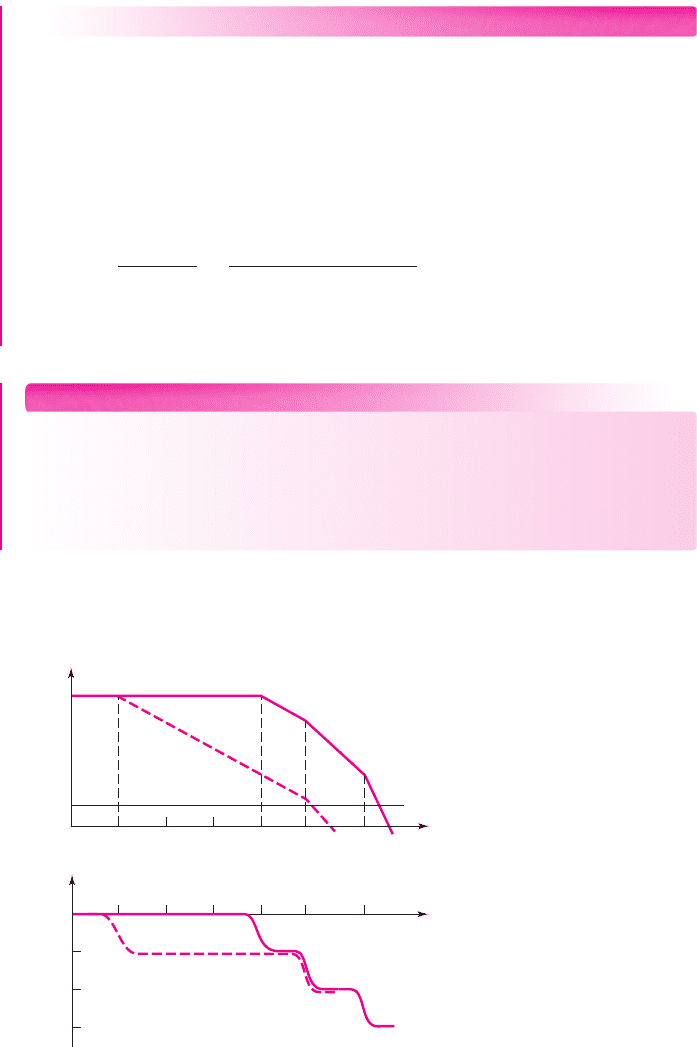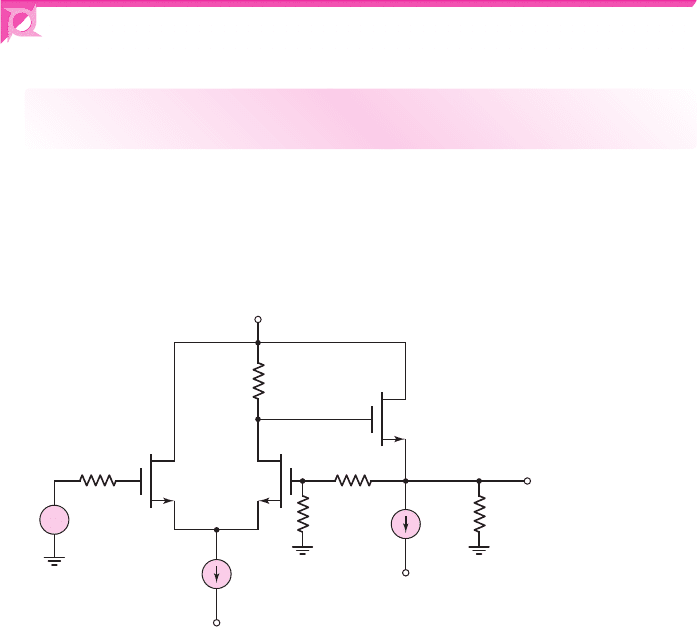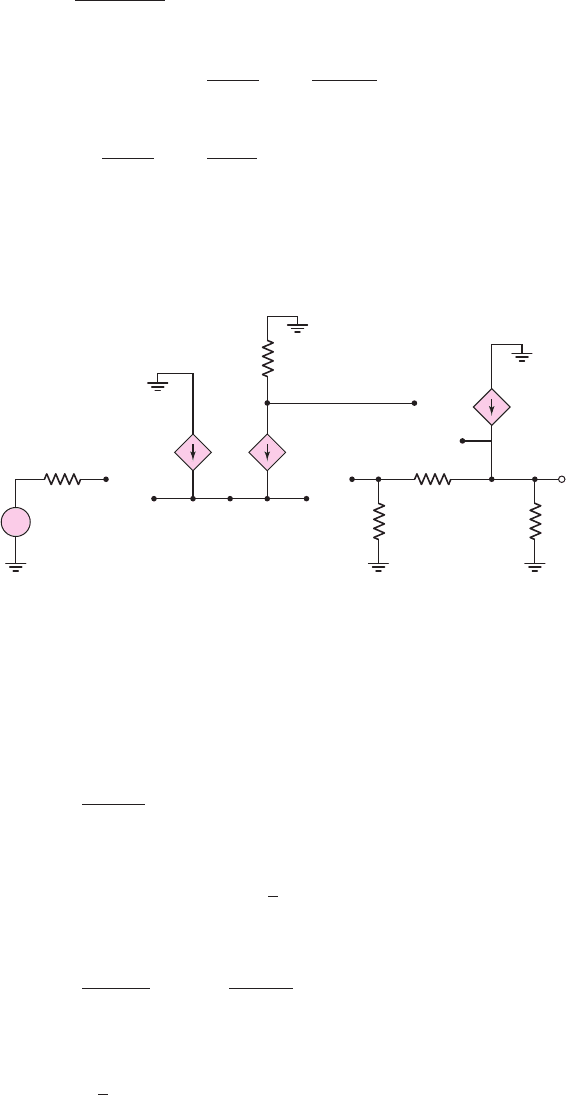Neamen D. Microelectronics: Circuit Analysis and Design
Подождите немного. Документ загружается.


EXERCISE PROBLEM
Ex 12.19: Consider the loop gain function
T
(
f
)
=
β
(
3000
)
1 + j
f
10
3
1 + j
f
10
5
2
For
β = 0.008
, determine the low-frequency closed-loop gain and the phase
margin. (Ans.
A
f
(
0
)
= 120
, phase margin
= 66.8
◦
)
Test Your Understanding
TYU 12.15 Consider the loop gain function given in Exercise Ex 12.19. Determine
the value of
β
that produces a phase margin of
45
◦
. (Ans.
β = 0.0167)
TYU 12.16 A two-pole feedback amplifier has an open-loop gain given by Equation
(12.113), with parameters: A
io
= 10
5
A/A, f
1
= 10
4
Hz, and f
2
= 10
5
Hz. The basic
amplifier is connected to a feedback circuit, for which the feedback transfer ratio
is
β
. Determine the value of
β
that results in a phase margin of 60 degrees. (Ans.
β = 9.73 ×10
−5
A/A)
TYU 12.17 For the loop gain function given in Example 12.18, determine the value
of
β
that produces a phase margin of 60 degrees. (Ans.
β = 0.0222
)
12.10 FREQUENCY COMPENSATION
Objective: • Consider frequency compensation techniques, methods
by which unstable feedback circuits can be stabilized.
In the previous section, we presented a method for determining whether a feedback
system is stable or unstable. In this section, we will discuss a method for modifying
the loop gain of a feedback amplifier, to make the system stable. The general tech-
nique of making a feedback system stable is called frequency compensation.
Basic Theory
One basic method of frequency compensation involves introducing a new pole in the
loop gain function, at a sufficiently low frequency that
|T ( f )|=1
occurs when
|
φ
|
< 180
◦
. As an example, consider the Bode plots of a three-pole loop gain magni-
tude and phase given in Figure 12.58 and shown by the solid lines. In this case, when
the magnitude of the loop gain is unity, the phase is nearly
−270
degrees and the
system is unstable.
If we introduce a new pole f
PD
at a very low frequency, and if we assume that
the original three poles do not change, the new Bode plots of the magnitude and
phase will be as shown by the dotted lines in Figure 12.58. In this situation, the
12.10.1
918 Part 2 Analog Electronics
nea80644_ch12_851-946.qxd 6/23/09 1:45 PM Page 918 pmath DATA-DISK:Desktop Folder:23/06/09:MHDQ134-12:

Chapter 12 Feedback and Stability 919
magnitude of the loop gain becomes unity when the phase is
|
φ
|
< 180
◦
, and the sys-
tem is stable. Since the pole is introduced at a low frequency and since it dominates
the frequency response, it is called a dominant pole. This fourth pole can be intro-
duced by adding a fourth stage with an extremely large input capacitance. Though
not practical, this method demonstrates the basic idea of stabilizing a circuit.
EXAMPLE 12.20
Objective: Determine the dominant pole required to stabilize a feedback system.
Consider a three-pole feedback amplifier with a loop gain given by
T ( f ) =
1000
1 + j
f
10
4
1 + j
f
10
6
1 + j
f
10
8
Insert a dominant pole, assuming the original poles do not change, such that the
phase margin is at least 45 degrees.
Solution: By inserting a dominant pole, we change the loop gain function to
T
PD
( f ) =
1000
1 + j
f
f
PD
1 + j
f
10
4
1 + j
f
10
6
1 + j
f
10
8
We assume that
f
PD
10
4
Hz
. A phase of
−135
degrees, giving a phase margin of
45 degrees, occurs approximately at
f
135
= 10
4
Hz.
Since we want the loop gain magnitude to be unity at this frequency, we have
|
T
PD
( f
135
)
|
= 1 =
1000
1 +
10
4
f
PD
2
1 +
10
4
10
4
2
1 +
10
4
10
6
2
1 +
10
4
10
8
2
f (Hz)
Phase
0
–90°
–180°
–270°
10
10
2
10
3
10
5
1
10
4
10
6
f (Hz)
10
10
2
10
3
10
5
10
4
10
6
f
PD
f
P1
f
P2
f
P3
|T ( f )|
Figure 12.58 Bode plots of loop gain magnitude and phase for three-stage amplifier,
before frequency compensation (solid curves), and after frequency compensation
(dotted curves)
nea80644_ch12_851-946.qxd 6/23/09 1:45 PM Page 919 pmath DATA-DISK:Desktop Folder:23/06/09:MHDQ134-12:

or
1 =
1000
1 +
10
4
f
PD
2
(1.414)(1)(1)
Solving for the dominant pole frequency
f
PD
, we find
f
PD
= 14.14 Hz
Comment: With high-gain amplifiers, the dominant pole must be at a very low
frequency to ensure stability of the feedback circuit.
EXERCISE PROBLEM
Ex 12.20: Consider a three-pole amplifier with a loop gain function given by
T( f ) =
250
1 + j
f
10
3
1 + j
f
10
5
2
(a) Show that the system is unstable. (b) Stabilize the circuit by inserting a new
dominant pole. Assume the original poles are not altered. At what frequency must
the new pole be placed to achieve a phase margin of
60
◦
. (Ans. (a) For
φ =
−180
◦
,
|
T
|
= 1.25 > 1
; (b)
f
PD
= 2.67
Hz)
Problem-Solving Technique: Frequency Compensation
1. To stabilize a circuit, insert a dominant pole or move an existing pole to a
dominant pole position (see next section). Assume that the dominant pole fre-
quency is small. Determine the frequency of the resulting loop gain function
to achieve the required phase margin.
2. Set the magnitude of the loop gain function equal to unity at the frequency
determined in step 1 to find the required dominant pole frequency.
3. To actually achieve the required dominant pole frequency in the circuit, a
number of techniques are available (for example, see Miller compensation).
One disadvantage of this frequency compensation method is that the loop gain
magnitude, and in turn the open-loop gain magnitude, is drastically reduced over a
very wide frequency range. This affects the closed-loop response of the feedback
amplifier. However, the advantage of maintaining a stable amplifier greatly outweighs
the disadvantage of a reduced gain, demonstrating another trade-off in design criteria.
Closed-Loop Frequency Response
Inserting a dominant pole to obtain the open-loop characteristics (dotted lines, Figure
12.58) is not as extreme or devastating to the circuit as it might first appear. Ampli-
fiers are normally used in a closed-loop configuration, for which we briefly consid-
ered the bandwidth extension, in Section 12.2.3.
12.10.2
920 Part 2 Analog Electronics
nea80644_ch12_851-946.qxd 6/23/09 1:45 PM Page 920 pmath DATA-DISK:Desktop Folder:23/06/09:MHDQ134-12:

Chapter 12 Feedback and Stability 921
For the region in which the frequency response is characterized by the dominant
pole, the open-loop amplifier gain is
A( f ) =
A
o
1 + j
f
f
PD
(12.122)
where A
o
is the low-frequency gain and f
PD
is the dominant-pole frequency. The
feedback amplifier closed-loop gain can be expressed as
A
f
( f ) =
A( f )
(1 + β A( f ))
(12.123)
where
β
is the feedback transfer ratio, which is assumed to be independent of fre-
quency. Substituting Equation (12.122) into (12.123), we can write the closed-loop
gain as
A
f
( f ) =
A
o
(1 + β A
o
)
×
1
1 + j
f
f
PD
(1 + β A
o
)
(12.124)
The term
A
o
/(1 + β A
o
)
is the closed-loop low-frequency gain, and
f
PD
(1 + β A
o
) = f
C
is the 3 dB frequency of the closed-loop system.
Figure 12.59 shows the Bode plot of the gain magnitude for the open-loop para-
meters
A
o
= 10
6
and
f
PD
= 10
Hz, at several feedback transfer ratios. As the
closed-loop gain decreases, the bandwidth increases. As previously determined, the
gain–bandwidth product is essentially a constant.
| A
f
|
f (Hz)
10
10
2
10
3
10
5
10
6
10
6
10
5
10
4
10
3
10
2
10
1
10
4
f
PD
f
C1
f
C2
f
C3
10
7
b = 0
b = 10
–4
b = 0.10
b = 2 × 10
–3
Figure 12.59 Bode plot, gain magnitude for open-loop and three closed-loop conditions
EXAMPLE 12.21
Objective: Determine the shift in the 3 dB frequency when an amplifier is operated
in a closed-loop system.
Consider an amplifier with a low-frequency open-loop gain of
A
o
= 10
6
and
an open-loop 3 dB frequency of
f
PD
= 10
Hz. The feedback transfer ratio is
β = 0.01
.
Solution: The low-frequency closed-loop gain is
A
f
(0) =
A
o
(1 + β A
o
)
=
10
6
1 + (0.01)(10
6
)
∼
=
100
nea80644_ch12_851-946.qxd 6/23/09 1:45 PM Page 921 pmath DATA-DISK:Desktop Folder:23/06/09:MHDQ134-12:

From Equation (12.124), the closed-loop 3dB frequency is
f
C
= f
PD
(1 + β A
o
) = (10)[1 +(0.01)(10
6
)]
or
f
C
∼
=
10
5
Hz = 100 kHz
Comment: Even though the open-loop 3 dB frequency is only 10 Hz, the closed-
loop bandwidth is extended to 100 kHz. This effect is due to the fact that the
gain–bandwidth product is a constant.
EXERCISE PROBLEM
Ex 12.21: An amplifier has an open loop response given by
A
(
f
)
=
10
5
1 + j
f
10
The amplifier is connected in a closed-loop configuration with
β = 0.025
. Deter-
mine the closed-loop low-frequency gain and closed-loop bandwidth. (Ans.
A
f
(
0
)
∼
=
40
,
f
C
∼
=
25
kHz)
Miller Compensation
As previously discussed, an op-amp consists of three stages, with each stage
normally responsible for one of the loop gain poles. Assume, for purposes of discus-
sion, that the first pole f
P1
is created by the capacitance effects in the second gain
stage. Instead of adding a fourth dominant pole to achieve a stable system, we can
move pole f
P1
to a low frequency. This can be done by increasing the effective input
capacitance to the gain stage.
Previously in Chapter 7, we determined that the effective Miller input capaci-
tance to a transistor amplifier is a feedback capacitance multiplied by the magnitude
of the gain of the amplifier stage. We can use this Miller multiplication factor to
stabilize a feedback system. The three-stage op-amp circuit is shown in Figure 12.60.
The second stage, an inverting amplifier, has a feedback capacitor connected
between the output and input. This capacitor C
F
is called a compensation capacitor.
The effective input Miller capacitance is
C
M
= C
F
(1 + A)
(12.125)
Since the gain of the second stage is large, the equivalent Miller capacitance will
normally be very large. The pole introduced by the second stage is approximately
f
P1
=
1
2π R
2
C
M
(12.126)
12.10.3
v
1
v
2
v
o
Diff-amp
stage
Output
stage
–A
C
F
Figure 12.60 Three-stage amplifier, including Miller compensation capacitor
922 Part 2 Analog Electronics
nea80644_ch12_851-946.qxd 6/23/09 1:45 PM Page 922 pmath DATA-DISK:Desktop Folder:23/06/09:MHDQ134-12:

Chapter 12 Feedback and Stability 923
where R
2
is the effective resistance between the amplifier input node and ground.
Resistance R
2
, then, is the parallel combination of the input resistance to the ampli-
fier and the output resistance of the diff-amp stage.
EXAMPLE 12.22
Objective: Determine the pole of the gain stage that includes a feedback capacitor.
Consider a gain stage with an amplification
A = 10
3
, a feedback capacitor
C
F
= 30 pF
, and a resistance
R
2
= 5 ×10
5
.
Solution: The effective input Miller capacitance is
C
M
= C
F
(1 + A)
∼
=
(30)(1000) pF = 3 ×10
−8
F
The dominant-pole frequency is therefore
f
P1
=
1
2π R
2
C
M
=
1
2π(5 ×10
5
)(3 × 10
−8
)
= 10.6Hz
Comment: The pole of the second stage can be moved to a significantly lower
frequency by using the Miller effect.
EXERCISE PROBLEM
Ex 12.22: The loop gain function of an amplifier is described in Exercise
Ex 12.20. To stabilize the circuit, the first pole at
f
P1
= 10
3
Hz is to be moved by
introducing a compensation capacitor. Assume the other two poles remain fixed.
Determine the frequency to which the first pole must be moved to achieve a phase
margin of
45
◦
. (Ans.
f
PD
= 194
Hz)
The effect of moving pole f
P1
, using the Miller compensation technique, is
shown in Figure 12.61. We assume at this point that the other two poles f
P2
and f
P3
|T ( f )|
Phase
0
–90°
–180°
–270°
1
f
P
′
1
f
P
′
1
f
P1
f
P2
f
P3
f
P1
f
P2
f
P3
Figure 12.61 Bode plots of loop gain for three-stage amplifier, before (solid curves) and after
(dotted curves) incorporating Miller compensation capacitor: (a) magnitude and (b) phase
nea80644_ch12_851-946.qxd 6/23/09 1:45 PM Page 923 pmath DATA-DISK:Desktop Folder:23/06/09:MHDQ134-12:

are not affected. Moving the pole f
P1
to
f
P1
means that the frequency at which
|T ( f )|=1
is lower, and that the phase is
|φ| < 180
◦
, which means that the ampli-
fier is stabilized.
A detailed analysis of the system using Miller compensation shows that pole f
P2
does not remain constant; it increases. This phenomenon is called pole-splitting. The
increase in f
P2
is actually beneficial, because it increases the phase margin, or the
frequency at which a particular phase margin is achieved.
12.11 DESIGN APPLICATION: A MOSFET
FEEDBACK CIRCUIT
Objective: • Redesign a BJT feedback circuit using MOSFETs.
Specifications: The circuit in Figure P12.36 is to be redesigned using MOSFETs.
The new circuit configuration is shown in Figure 12.62. The output voltage is to be
zero for
v
i
= 0
.
V
+
= 12 V
M
3
M
1
M
2
2 mA
1 mA
V
–
V
–
R
2
= 40 kΩ
R
1
=
10 kΩ
v
o
v
i
R
L
=
4 kΩ
R
S
= 1 kΩ
R
D
+
–
Figure 12.62 A MOSFET feedback circuit for the design application
924
Part 2 Analog Electronics
Choices: Assume that NMOS devices are available with parameters
V
TN
= 1
V,
K
n
= 1
mA/V
2
, and
λ = 0
.
Solution (DC Design): For
v
O
= 0
, the current in M
3
is
I
D3
= 2
mA. Then
I
D
= K
n
(V
GS3
− V
TN
)
2
or
2 = (1)
(
V
GS3
−1
)
2
which yields
V
GS3
= 2.414 V
nea80644_ch12_851-946.qxd 6/23/09 1:45 PM Page 924 pmath DATA-DISK:Desktop Folder:23/06/09:MHDQ134-12:

Chapter 12 Feedback and Stability 925
The voltage at the gate of M
3
is then to be
V
G3
= 2.414
V. The current in M
2
is
0.5 mA, so the resistance R
D
is
R
D
=
12 − 2.414
0.5
= 19.2k
Solution (AC Analysis): We can find the small-signal parameters as
g
m1
= g
m2
≡ g
m
= 2
K
n
I
D1
= 2
(1)(0.5) = 1.414
mA/V
and
g
m3
= 2
K
n
I
D3
= 2
(1)(2) = 2.828
mA/V
The small-signal equivalent circuit is shown in Figure 12.63. Summing currents
at the V
1
node, we have
g
m
V
gs1
+ g
m
V
gs2
= 0 ⇒ V
gs2
=−V
gs1
g
m1
V
gs1
g
m2
V
gs2
g
m3
V
gs3
V
i
V
o
+
–
+
–
V
gs1
V
1
+
+
–
–
V
gs2
V
gs3
R
2
= 40 kΩ
R
1
= 10 kΩ
V
2
R
S
= 1 kΩ
R
L
=
4 kΩ
R
D
Figure 12.63 Small-signal equivalent circuit of the MOSFET feedback circuit for the design
application
Writing a KVL equation from the input, we find
V
i
= V
gs1
− V
gs2
+ V
2
=−2V
gs2
+ V
2
or
V
gs2
=
V
2
− V
i
2
We see that
V
gs3
=−g
m
V
gs2
R
D
− V
o
=−
1
2
(
V
2
− V
i
)
R
D
− V
o
Also
V
2
=
R
1
R
1
+ R
2
V
o
=
10
10 + 40
V
o
= 0.2 V
o
so that
V
gs3
=−
1
2
g
m
[
(0.2)V
o
− V
i
]
R
D
− V
o
nea80644_ch12_851-946.qxd 6/23/09 1:45 PM Page 925 pmath DATA-DISK:Desktop Folder:23/06/09:MHDQ134-12:

Summing currents at the output node, we obtain
g
m3
V
gs3
=
V
o
R
L
+
V
o
R
1
+ R
2
or
g
m3
−
1
2
g
m
[
(0.2)V
o
− V
i
]
R
D
− V
o
=
V
o
R
L
+
V
o
R
1
+ R
2
Combining terms, we obtain
1
2
g
m3
g
m
R
D
V
i
= V
o
g
m3
1 +
1
2
g
m
(0.2)R
D
+
1
R
L
+
1
R
1
+ R
2
(12.127)
Substituting parameters, we find
1
2
(2.828)(1.414)(19.2)V
i
= V
o
(2.828)
1 +
1
2
(1.414)(0.2)(19.2)
+
1
4
+
1
10 + 40
The closed-loop voltage gain is then
A
v
=
V
o
V
i
= 3.56
Solution (Gain Variations): One of the advantages of feedback is that the
closed-loop gain is relatively insensitive to changes in the individual transistor
parameters. Determine the closed-loop gain if the conduction parameters decrease
by 10 percent.
The new values of the small-signal parameters are
g
m1
= g
m2
≡ g
m
= 2
K
n
I
D1
= 2
(0.9)(0.5) = 1.342
mA/V
and
g
m3
= 2
K
n
I
D3
= 2
(0.9)(2) = 2.683
mA/V
Substituting these values into Equation (12.127), we obtain
1
2
(2.683)(1.342)(19.2)V
i
= V
o
(2.683)
1 +
1
2
(1.342)(0.2)19.2
+
1
4
+
1
10 + 40
The closed-loop gain is then
A
v
=
V
o
V
i
= 3.50
Comment: With a decrease of 10 percent in the transistor conduction parameters, the
closed-loop gain has decreased by less than 2 percent. Even though we are considering
a relatively simple feedback circuit with only three transistors, the advantage of feed-
back is observed.
926 Part 2 Analog Electronics
nea80644_ch12_851-946.qxd 6/23/09 1:45 PM Page 926 pmath DATA-DISK:Desktop Folder:23/06/09:MHDQ134-12:

Chapter 12 Feedback and Stability 927
12.12 SUMMARY
•
combined with the input signal. In negative feedback, a portion of the output
signal is subtracted from the input signal. In positive feedback, a portion of the
output signal is added to the input signal.
• An important advantage of negative feedback is that the closed-loop amplifier
gain is essentially independent of individual transistor parameters and is a func-
tion only of the feedback elements.
• Negative feedback increases bandwidth, may increase the signal-to-noise ratio,
reduces nonlinear distortion, and controls input and output impedance values at
the expense of reduced gain magnitude.
• There are four basic feedback topologies. A series input connection is used when
the input signal is a voltage, and a shunt input connection is used when the input
signal is a current. A series output connection is used when the output signal is a
current, and a shunt output connection is used when the output signal is a voltage.
• The loop gain factor of a feedback amplifier is defined as
T = Aβ
, which is
dimensionless and where
A
is the gain of the basic amplifier and
β
is the feed-
back factor. The loop gain is a function of frequency and is complex when the
input capacitance of each transistor stage is taken into account.
• A three-stage negative feedback amplifier is guaranteed to be stable when, at the
frequency for which the phase of the loop gain is
−180
degrees, the magnitude
of loop gain is less than unity.
• A common technique of frequency compensation utilizes the Miller multiplica-
tion effect by incorporating a feedback capacitor across, usually, the second
stage of the amplifier.
• As an application, a MOSFET feedback circuit was designed.
CHECKPOINT
, the reader should have the ability to:
✓ Describe the ideal feedback circuit configuration.
✓ Describe some of the advantages and disadvantages of negative feedback.
✓ Discuss the general characteristics of the four basic feedback configurations in
terms of input and output signals and input and output resistances.
✓ Design a feedback circuit given the input signal and desired output signal.
✓ Determine the loop gain of a feedback circuit.
✓ Determine whether or not a three-stage feedback amplifier is stable.
✓ Stabilize a three-stage amplifier using frequency compensation techniques.
✓ Analyze op-amp and discrete transistor circuits that are examples of the four
basic feedback configurations.
REVIEW QUESTIONS
disadvantages of each type?
2. Write the ideal form of the general feedback transfer function.
3. Define the loop gain factor.
4. What is the difference between open-loop gain and closed-loop gain?
nea80644_ch12_851-946.qxd 6/23/09 1:45 PM Page 927 pmath DATA-DISK:Desktop Folder:23/06/09:MHDQ134-12:
In a feedback circuit, a portion of the output signal is fed back to the input and
After studying this chapter
1. What are the two general types of feedback and what are the advantages and
